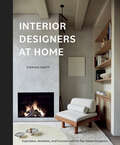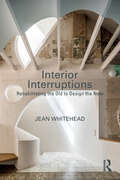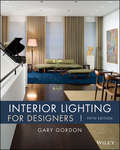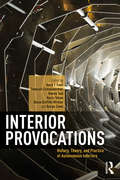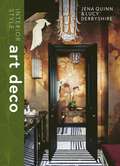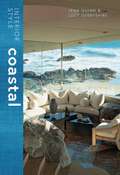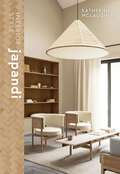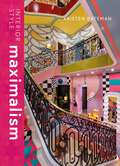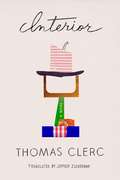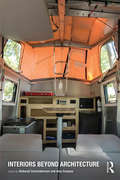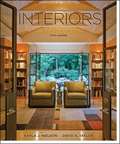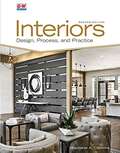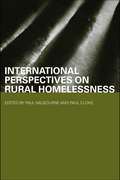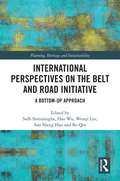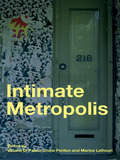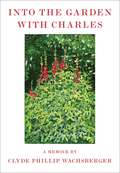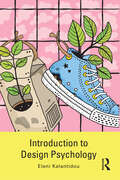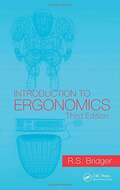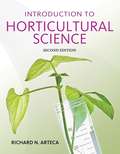- Table View
- List View
Interior Designers at Home: Inspiration, Aesthetic, and Function with 20 Top Global Designers
by Stephen CraftiAuthor is well-connected with marketing channels and has a charismatic public presence. Books on interior designers' own homes are perennial sellers.
Interior Interruptions: Rehabilitating the Old to Design the New
by Jean WhiteheadInterior Interruptions examines the role of the ‘palimpsest’ and its relationship to narrative, sustainability, renovation and adaptive reuse. By exploring storytelling, palimpsestic characteristics and techniques, the book argues that these devices play a central role in the consideration of the designed interior.Narrative has a burgeoning relationship with the palimpsest and this approach embraces an aesthetic of incompleteness and imperfection as a site rich response. It recognises the ongoing ‘biography’ or heritage of a building as a form of transient architectural narrative that encourages reuse through the continual process of writing, rewriting, overwriting and unwriting. This process has sustainable, societal, archaeological and textual connotations that can be interpreted as a process of ‘layering’ whereby the architectural shell is viewed as a container; a rich repository that is ‘overlain’ by surface changes, documents architectural and spatial modifications, and is populated by interior fixtures and fittings that all unite to create an ever-changing interior story.Exploring case studies from the UK, Netherlands, Palestine, Belgium, Singapore, Spain, Portugal, France, Germany, Brazil, Japan, USA and China and beautifully illustrated in full colour, this book proposes that the act of interior renovation can be viewed as a perpetual form of revisionary storytelling re-imagined as a series of temporal interior ‘interruptions’. It is essential reading for students and professionals interested in the built environment, including, but not limited to, interior design, interior decoration, interior architecture and architecture.
Interior Lighting for Designers
by Gary GordonThis revised edition of the successful primer thoroughly covers fundamentals of lighting design, and also serves as a handy reference for professional designers. The Fifth Edition is more comprehensive than ever, with new information on LED, energy efficiency, and other current issues. In addition, it includes more information for drawing ceiling floor plans and the application of designs to specific types of interiors projects. Considered a "key reference" for the Lighting Certified exam, no other text combines both technical and creative aspects of lighting design for beginners and novice designers.
Interior Provocations: History, Theory, and Practice of Autonomous Interiors
by Anca I. Lasc, Deborah Schneiderman, Keena Suh, Karin Tehve, Alexa Griffith Winton, and Karyn ZieveInterior Provocations: History, Theory, and Practice of Autonomous Interiors addresses the broad cultural, historical, and theoretical implications of interiors beyond their conventionally defined architectural boundaries. With provocative contributions from leading and emerging historians, theorists, and design practitioners, the book is rooted in new scholarship that expands traditional relationships between architecture and interiors and that reflects the latest theoretical developments in the fields of interior design history and practice. This collection contains diverse case studies from the late eighteenth century to the twenty-first century including Alexander Pope’s Memorial Garden, Design Indaba, and Robin Evans. It is an essential read for researchers, practitioners, and students of interior design at all levels.
Interior Style: Art Deco
by Jena Quinn Lucy DerbyshireArt Deco captures the vitality and modernity of the Jazz Age. From the refined interiors of 1920s Paris to the decadent and luxurious glamour of Hollywood, the bold geometry, simplicity of form and luxurious materials of Art Deco still feel distinctly modern today.With a historical overview and examples of stunning interiors, Interior Style: Art Deco explores the design essence of the era.With in-depth professional advice on how to use elements such as pattern, lighting, furniture and textiles, you will find the tools to recreate this sophisticated elegance in your own home.
Interior Style: Art Deco
by Jena Quinn Lucy DerbyshireArt Deco captures the vitality and modernity of the Jazz Age. From the refined interiors of 1920s Paris to the decadent and luxurious glamour of Hollywood, the bold geometry, simplicity of form and luxurious materials of Art Deco still feel distinctly modern today.With a historical overview and examples of stunning interiors, Interior Style: Art Deco explores the design essence of the era.With in-depth professional advice on how to use elements such as pattern, lighting, furniture and textiles, you will find the tools to recreate this sophisticated elegance in your own home.
Interior Style: Coastal
by Jena Quinn Lucy DerbyshireExpansive, sun-drenched spaces, unobstructed views to the outdoors and easy-going comfort - coastal design captures the spirit and escapism of seaside living. Illustrated with breathtaking interiors and inspirational showpiece homes, Interior Style: Coastal traces the evolution of the aesthetic from the white villas of the Riviera to the California Look of the USA's West Coast. With in-depth professional advice on how to use elements such as colour, texture and pattern, you will discover how to bring the tranquillity of coastal life into your home.
Interior Style: Coastal
by Lucy Derbyshire Jenna QuinnExpansive, sun-drenched spaces, unobstructed views to the outdoors and easy-going comfort - coastal design captures the spirit and escapism of seaside living. Illustrated with breathtaking interiors and inspirational showpiece homes, Interior Style: Coastal traces the evolution of the aesthetic from the white villas of the Riviera to the California Look of the USA's West Coast. With in-depth professional advice on how to use elements such as colour, texture and pattern, you will discover how to bring the tranquillity of coastal life into your home.
Interior Style: Japandi (Interior Styles)
by Katherine McLaughlinCapture the Japanese-meets-Scandi trend with in-depth practical advice on how to use colour, texture, lighting and more, all accompanied by images of gorgeous interiors and inspirational showpiece homes.A fusion of functional Eastern minimalism with clean Scandi cosiness, the japandi interior style creates a tranquil home with its focus on warmth, simplicity, natural elements and muted colours. Elements such as bamboo, wood and stone, along with clean lines and uncluttered spaces make a restful environment. With a historical overview of the decor, and illustrated with examples of notable interiors and key elements of lighting, furniture, colour palette, texture and textile, Japandi offers practical advice on how to recreate the look in your own home.With a historical overview of the decor, and illustrated with examples of notable interiors and key elements of lighting, furniture, colour palette, texture and textile, the book offers practical advice on how to recreate the look in your own home.
Interior Style: Japandi (Interior Styles)
by Katherine McLaughlinCapture the Japanese-meets-Scandi trend with in-depth practical advice on how to use colour, texture, lighting and more, all accompanied by images of gorgeous interiors and inspirational showpiece homes.A fusion of functional Eastern minimalism with clean Scandi cosiness, the japandi interior style creates a tranquil home with its focus on warmth, simplicity, natural elements and muted colours. Elements such as bamboo, wood and stone, along with clean lines and uncluttered spaces make a restful environment. With a historical overview of the decor, and illustrated with examples of notable interiors and key elements of lighting, furniture, colour palette, texture and textile, Japandi offers practical advice on how to recreate the look in your own home.With a historical overview of the decor, and illustrated with examples of notable interiors and key elements of lighting, furniture, colour palette, texture and textile, the book offers practical advice on how to recreate the look in your own home.
Interior Style: Maximalism
by Kristen BatemanThe extrovert of interior design and the definition of 'more is more', maximalism is an exuberant celebration of pattern, colour and texture that deliberately clash. Its roots lie in 1930s Hollywood Regency style, Rococo and Neoclassicism, as well as Greek, Egyptian and Asian styles.With a historical overview of the decor, and illustrated with examples of notable interiors and key elements of lighting, furniture, colour palette, texture and textile, the book offers practical advice on how to recreate the look in your own home.
Interior Style: Maximalism
by Kristen BatemanThe extrovert of interior design and the definition of 'more is more', maximalism is an exuberant celebration of pattern, colour and texture that deliberately clash. Its roots lie in 1930s Hollywood Regency style, Rococo and Neoclassicism, as well as Greek, Egyptian and Asian styles.With a historical overview of the decor, and illustrated with examples of notable interiors and key elements of lighting, furniture, colour palette, texture and textile, the book offers practical advice on how to recreate the look in your own home.
Interior: A Novel
by Jeffrey Zuckerman Thomas Clerc"Haunting, a book of ghosts and a book of this moment." —Parul Sehgal, The New York TimesA comic experiment in sociology and self-absorption, the award-winning author Thomas Clerc’s autobiographical Interior is a unique invitation into a professor’s preoccupations and possessions within the rooms of a small Parisian apartment. Composed of bite-size vignettes, remembrances, and digressions, and filled with lighthearted transitions from pure description to quirky reminiscence and back, this meticulous tour through the rooms of Clerc’s home reveals fascinating insights into the author’s obsessions, desires, and frustrations. Each space is described in painstaking detail, sometimes down to the centimeter, and the history of every object and appliance is fully excavated with self-deprecating wit. From the ideal varieties of bathroom reading material to the color of his dish rack to the chaos of his sock drawer, Clerc happily and shamelessly guides us through the most intimate crannies of his home, as well as through all the strata of his existence as a bourgeois city dweller approaching middle age. Playful and irreverent, as well as a sly commentary on materialism, Interior finds drama in the domestic and dark humor in every doomed attempt to express individuality through the things that we own.
Interiors Beyond Architecture
by Deborah Schneiderman Amy CamposInteriors Beyond Architecture proposes an expanded impact for interior design that transcends the inside of buildings,?analysing significant interiors that engage space outside of the disciplinary boundaries of architecture. It presents contemporary case studies from a historically nuanced and theoretically informed perspective, presenting a series of often-radical propositions about the nature of the interior itself. Internationally renowned contributors from the UK, USA and New Zealand present ten typologically specific chapters including: Interiors Formed with Nature, Adaptively Reused Structures, Mobile Interiors, Inhabitable art, Interiors for Display and On Display, Film Sets, Infrastructural Interiors, Interiors for Extreme Environments, Interior Landscapes, and Exterior Interiors.
Interiors: An Introduction Fifth Edition
by Karla J. Nielson David A. TaylorInteriors: An Introduction is the starting point for a lifetime of design education, appreciation, and enjoyment. Whether the goal is a career in interior design, or simply a better understanding of how to enhance one's own living space, the information and ideas in this text will help readers achieve it. Interiors offers an introduction to the elements, practice, and aesthetics of residential and nonresidential interior design, as well as their applications. In addition, the authors describe the numerous choices of materials, furnishings, and components used in interior design.
Interiors: Design, Process, and Practice
by Stephanie A. ClemonsInteriors: Design, Process, and Practice, offers a comprehensive and up-to-date overview of a profession that is never static or predictable because its focus is on people. From its historical roots to best business practices, this study of interiors introduces the reader to the processes, skills, and practices foundational to good design. <p><p> With emphasis on the elements and principles of design, the design process, visual communications, and selecting materials, furnishings, and accessories, Interiors features contributions by renowned interior designers. In addition, it brings to light a local and global design perspective, representing both residential and commercial design.
Intermodal Freight Transport
by David LoweThis book provides an introduction to the whole concept of intermodal freight transport, the means of delivering goods using two or more transport modes, recounting both European experience and UK developments and reporting on the extensive political influences on this form of transport. This is placed into context with reference to developments in North America and Asia.Detailed explanations are given of the road and rail vehicles, the loading units and the transfer equipment used in such operations. In particular, the role of the Channel Tunnel in the development of long-haul combined transport operations between the UK and Europe is considered.
International Perspectives on Rural Homelessness (Housing, Planning and Design Series)
by Paul Cloke Paul MilbourneDrawing on recent academic studies in North America, Europe, Australia and New Zealand, this book is the first international text on homelessness in rural areas. Consisting of fifteen specially commissioned chapters, International Perspectives on Rural Homelessness provides comparative material on the cultural, political and policy contexts of rural homelessness, examining the nature and scale of the issue and the complex local geographies of rural homelessness.
International Perspectives on the Belt and Road Initiative: A Bottom-Up Approach (Planning, Heritage and Sustainability)
by Shannon Morreira Hao Wu Sun Sheng Han Bo Qin Wenqi LinInternational Perspectives on the Belt and Road Initiative investigates the most significant global‐scale international trade expansion and capital investment programme since the Second World War. This book focuses on the multi-national perspectives of the Belt and Road Initiative (BRI) in order to interrogate the Chinese government’s representation of it as a symbol of ‘peace, cooperation, development and mutual benefit.' With specific focus on the interrelationship between geopolitics, infrastructure investments and urban regional development, the book reflects on 12 countries’ experiences in depth, including those of Iran, Pakistan, Brazil, Thailand, Indonesia, Japan and Ethiopia, specificly to their economic development levels, political systems, power dynamics and socio-environmental issues. The book clarifies and contributes new knowledge on the nature of BRI concerning its relationship to globalism, neo-colonialism, the notion of developed vs developing countries and their institutions and macro-micro benefits and impacts. In doing so, the book offers a balanced account of the antagonistic geo-political narrative of socio-political conflict and the collaborative framework of real socio-economic flows and development. The book will appeal to academics, researchers and policy-makers with an interest in the BRI and its impacts on politico-economic development and urban, regional and spatial systems in the Indo-Pacific and beyond.
Intimate Metropolis: Urban Subjects in the Modern City
by Vittoria Di Palma Diana Periton Marina LathouriIntimate Metropolis explores connections between the modern city, its architecture, and its citizens, by questioning traditional conceptualizations of public and private. Rather than focusing purely on public spaces—such as streets, cafés, gardens, or department stores—or on the domestic sphere, the book investigates those spaces and practices that engage both the urban and the domestic, the public and the private. The legal, political and administrative frameworks of urban life are seen as constituting private individuals’ sense of self, in a wide range of European and world cities from Amsterdam and Barcelona to London and Chicago. Providing authoritative new perspectives on individual citizenship as it relates to both public and private space, in-depth case studies of major European, American and other world cities and written by an international set of contributors, this volume is key reading for all students of architecture.
Into the Garden With Charles: A Memoir
by Clyde Phillip WachsbergerSet in the tiny village of Orient, Long Island, and in New York City, Into the Garden with Charles is a memoir about falling in love. As a boy in suburban New York in 1940s, Clyde Wachsberger daydreams about storybook gardens where magic happens under the huge leaves. Through the 1960s and 1970s, when most gay men disdained monogamy, the author--an artist and set-designer in New York City--searches unsuccessfully for a soul mate. In 1983, approaching middle-age and having given up on finding love, he moves to a three-hundred-year-old house on a third of an acre, where he channels his passion into creating a garden appropriate to his historical home. Then remarkable circumstances lead him to Charles--a connoisseur of art, a gardener, and the man who will become his life-partner. Together they create a garden of sensuous wild beauty. Into the Garden with Charles is infused with the author's artistic sensibility and is written in a voice that is unaffected, generous, and straightforward. Enriched with the author's paintings--giving it the look and feel of an antique children's book--Into the Garden with Charles is a unique and moving memoir about growing old and falling in love.
Introduction to Design Psychology
by Eleni KalantidouIn the age of climate change, psychology and design have been employed through impromptu collaborations to validate solutions and future scenarios.Introduction to Design Psychology contests this approach by proposing an ideological framework for an intentional, joint endeavour between psychology and design. Intentional design psychology is presented as a critical proposal grounded in unpredictability, nominating ways to activate new production, consumption, and habitation patterns. It unfolds through chapters exploring urban environments, technology, and consumer culture, making evident the need for new definitions of social resilience and adaptation. As part of this process, adaptive designs that enable resilient psychologies are revealed. By challenging the disciplinary status quo of psychology and design, this book aims to activate a new field of knowledge.Introduction to Design Psychology is essential for psychologists, designers, and urban planners, as well as professionals from affiliated fields, willing to reconfigure their own thinking and practice.
Introduction to Ergonomics
by R. S. BridgerThe past decade has seen the development and testing of an increasingly large set of ergonomics tools. With new sections in every chapter, the third edition of Introduction to Ergonomics describes a representative selection of tools and demonstrates how to apply them in practice. In fully researched, stand alone sections with worked examples, the book provides useful, practical skills for dealing with real-world ergonomic problems. The author’s approach is based on a professional model in which specialized skills are backed-up by a good general knowledge of ergonomics. This approach is in accordance with International Ergonomics Association guidelines. <p><p> See what’s new in the Third Edition: <p>• Ergonomics Workshop sections in each chapter with worked examples and advice for using problem solving tools <p>• Guidance for the design of questionnaires, rating scales, and the conduct of surveys applicable across all areas of ergonomics <p>• Task analysis examples together with a wide variety of ergonomics checklists and design guidelines <p>• Increased coverage of the role of stress and psychological well-being on the health of workers and on systems safety <p>• New material for course lectures, examinations, and projects—over 200 essays and exercises <p>• Glossary of technical terms <p>• New evidence for the cost-effectiveness of ergonomics in practice <p>• Advice for further study <p>• Updated Instructor’s Manual <p><p>The book’s built-in flexibility allows it to be used in a variety of ways. Reading the main text supplies a general overview of ergonomics in action. Delving deeper, the Ergonomics Workshop sections include tutorials and exercises that provide a basic toolkit for carrying out risk assessments and for solving real-world problems. This multi-level organization allows those studying human factors, psychology, industrial engineering, and occupational ergonomics to get both general knowledge and specialized information. The self-contained chapters are also accessible to non-ergonomics professionals who need to know more about the subject.
Introduction to Horticultural Science (Second Edition)
by Richard N. ArtecaDesigned to provide readers with a full appreciation of the wonderful world of horticultural science, the Second Edition of INTRODUCTION TO HORTICULTURAL SCIENCE covers everything the reader needs to know in a comprehensive format that is easy to understand. Coverage includes critical topics such as fundamental concepts, cutting edge research, careers in horticulture, the relationship between horticulture and the environment, classification of plants, and plant anatomy. Readers are also introduced to key concepts such as plant propagation, media, nutrients and fertilizers, plants and the environment, plant growth regulators, post harvest physiology and pest management, greenhouse structures, nursery site selection, development and facilities, producing nursery crops, and floral design. Through enhanced visual aids and the inclusion of recent trends in the field, the second edition has been designed to peak reader interest and improve reader understanding.
Introduction to Horticulture (4th edition)
by Charles B. Schroeder Eddie Dean Seagle Gerard Krewer John M. Ruter Lorie M. Felton William Terry KellyThe Fourth Edition of Introduction to Horticulture represents a major step forward for horticulture books in agricultural education. The attractive, student-friendly book has been expanded and made much more appealing. Changes from the prior editions have made this book increasingly useful in the hands of students.
